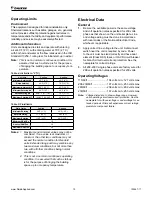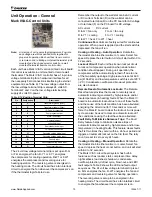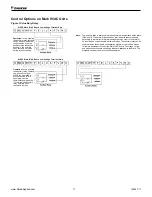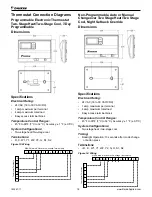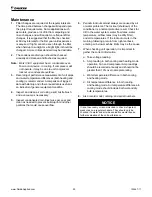
www.DaikinApplied.com
25
IM 447-11
Maintenance
1.
Filter changes are required at the regular intervals.
The time period between changes will depend upon
the project requirements. Some applications such
as motels, produce a lot of lint from carpeting and
linen changes, and will require more frequent filter
changes. It is suggested that the filter be checked
at 60 day intervals for the first year until experience
is acquired. If light cannot be seen through the filter
when held up to sunlight or a bright light, it should be
changed. A more critical standard may be desirable.
2.
The condensate drain pan should be checked
annually and cleaned and flushed as required.
Note:
Mark IV/AC equipment has a condensate over-
flow control device. In cooling, if compressor will
not operate, it may be due to unit compressor
lockout on condensate overflow.
3.
Recording of performance measurement of volt amps
and water temperature differences (both heating and
cooling) is recommended. A comparison of logged
data with start-up and other annual data is useful as
an indicator of general equipment condition.
4.
Inspect and clean air coil using a soft bristle brush
and a vacuum as neccessary.
5.
Inspect condensate drain lines twice per year and
clean as needed to prevent build-up lint and other
particles that could cause overflow.
6.
Periodic lockouts almost always are caused by air
or water problems. The lockout (shutdown) of the
conditioner is a normal protective result. Check for
dirt in the water system, water flow rates, water
temperature, airflow rates (may be dirty filter),
and air temperatures. If the lockout occurs in the
morning following a return from night setback,
entering air below machine limits may be the cause.
7.
When checking unit operation, it is important to
gather the correct information.
a. Take voltage reading.
b. Amp reading in both cooling and heating mode
operation. Fan and compressor Amp readings
should be recorded annually and should not be
greater than 10% over nameplate rating.
c. Water temperature difference in both cooling
and heating mode.
d. Air temperature difference in both cooling
and heating mode. Air temperature difference in
cooling mode should include both wet and dry
bulb temperatures.
8.
Also record model, catalog, and serial numbers.
NOTICE
It is not neccesary or recommended to check refrigerant
pressures on a regular schedule. They should only be
checked if a water and air side evaluation would require
further evaluation of the unit performance.



